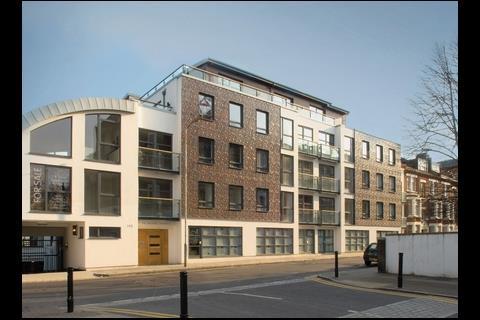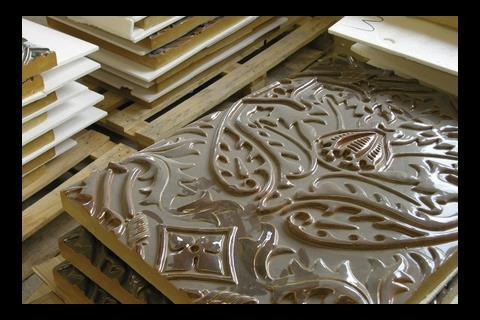Like an old punk band that reunites for one last gig, glazed terracotta tiles – famous for their early appearances on Victorian pubs and tube stations – are making a comeback. Stephen Kennett gives a big hand to two completed schemes that are shaking up the streets of London
The wallpaper factory
“What I like most is the texture of the tiles and the way the light interacts with them,” says Malcolm Last of Chassay + Last Architects. His firm has just used 264 handmade terracotta panels to create the street frontage of the mixed-use development of 10 live-work units and 14 apartments in Islington, north London, it completed for developer London Newcastle (pictured).
The design of the facade celebrates the site’s former use as a factory for wallpaper manufacturer Cole & Son. Last says the original plan was to etch a wallpaper motif into glass mosaic, but the council denied permission for this. “The planners wanted more traditional materials to be used, in keeping with the surrounding buildings,” he says. “They also didn’t want a flat finish.”
To meet these requirements, the architect came up with the idea of using terracotta panels for the rainscreen cladding. The client managed to acquire two of the original wooden blocks that Cole & Son had used to print wallpapers. Chassay + Last used the less intricate of the two as the basis for the look of the cladding.
Translating the pattern into something that would work on the building’s four-storey facade, however, was far less straightforward. Numerous iterations were tried to find the best scale, repetition sequence and size of the tiles to tie in with the window openings.
Shaws of Darwen manufactured the panels. “Getting Shaws on board gave us the confidence that we could do it,” says Chassay + Last associate Jonathan Gidley.
First, a sculptor translated the design onto a clay block, from which plaster moulds were cast. Only about six terracotta panels could be cast from each mould before it began to lose definition and a new one was required.
Various coloured glazes were tried out and fired on a prototype panel. “Originally we wanted a white finish, but this would have shown up dirt,” says Last. Eventually, the team settled on a brown colour, and the panels were doubled glazed to highlight the pattern.
In total, six patterns were developed in two tile sizes, the bigger of which measured 595mm x 825mm. They were all 50mm thick, which the architect says was the ideal compromise between robustness and weight. As the panels came off the production line, they were laid out on the factory floor in a mock-up of the building front. “Because there was a slight variation in the finished colour, we needed to arrange the panels to get the best match,” explains Gidley. Each panel was then numbered ready for installation.
The facade was installed by Gormley (Masonry Services), and attached to the building using a simple angled bracket at the base to support the panels with a pin holding each in place. A metal edge is used to frame the panelled elevations and hide the unglazed edge of the tiles. In total, it took six months from inception to the panels being ready, and a further two months for installation. Last says he is pleased with the end result. “The juxtaposition of the panels and the modern building works well,” he says. “It mixes something traditional with today’s modern methods of construction.”
From a distance people have said it almost looks like Virginia creeper, says Gidley.
Sir John Lyon House
When Sidell Gibson Architects began looking for a suitable cladding material for a residential development on the north bank of the Thames, it needed something suitably industrial to fit in with the surroundings. The material also had to be almost maintenance free, as Sir John Lyon House is virtually on the water’s edge. Glazed terracotta piqued their attention by accident. “The planners said they would be interested in seeing more glazed terracotta rainscreen in the City, which got us thinking about this material,” says Richard Morton, the project architect.
When the design team began looking into using the material, they discovered an almost limitless number of colours were available – for conventional unglazed terracotta tiles there were far fewer.
“We decided to exploit this by using a graduation of colour on the facade,” Morton explains.
Then began an arduous search for a suitable product. “There is a huge range of colours, but pinning down any specific one is very difficult. It’s not like choosing a colour for your paintwork – you have to make a glaze from a set of chemicals and there is little certainty of how it will come out once it’s fired.” This means coming up with an exact colour is a case of trial and error.
The designers wanted to use six different colours, varying from a deep orange to a light straw shade. “When we decided on this, we printed out coloured strips and sent them to cladding suppliers who tried to match them to their standard products,” says architect Richard Lee. “Most couldn’t match what we were asking for. It took six months before a German company was found with such a vast range of specialist colours that an almost exact match could be guaranteed. “Without their recipes, the process would have been incredibly laborious. It would have delayed the project and the cost would have been prohibitive,” says Lee.
The tiles were supplied by EH Smith. There was a further bonus of using their system – Hydrotec coating is baked on during the production process and contains an agent that makes the tile surface hydrophilic. This means water spreads in a thin film across the surface of the tile, helping it remain clean. Lee has observed this in action. “The non-terracotta parts of the structure, become dirty but the tiles remain pristine,” he says.
The installation took a matter of weeks. The builders reused the existing sixties concrete frame, which pre-determined the size of the tiles used. The tiles are lightweight and were slid into position along aluminium rails attached to the steel frame behind.
The result of using the glazed terracotta is that the facade changes constantly throughout the day, says Lee. “When exposed to direct sunshine the contrast of the tiles against the aluminium framing is dramatic, while under lower light it is less so. Even the rain creates a different effect.”
Postscript
Original print headline: Give it up for the ceramic street features!
Specifier 27 February 2009

- 1
- 2
- 3
- 4
- 5
- 6
- 7
- 8
- 9
 Currently
reading
Currently
reading
The return of the glazed terracotta tile





































No comments yet